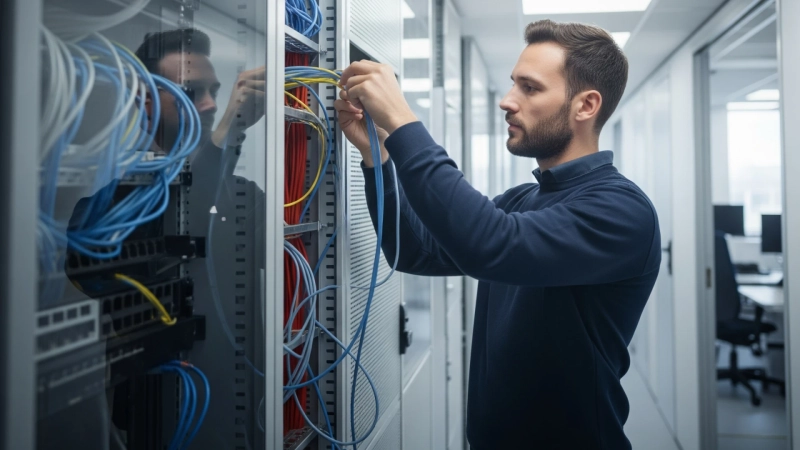In today’s digital world, data centers are the heart of business operations. Everything from websites to emails to cloud services depends on data centers running smoothly. One of the most important parts of a data center is its structured cabling system.
A well-designed cabling system helps your data center stay fast, organized, and ready for the future. In this article, we’ll look at why structured cabling matters and what to think about when setting it up.
What Is Structured Cabling in Data Centers?
Structured cabling is a planned way of organizing cables in a building or data center. It includes:
- Copper or fiber optic cables
- Patch panels
- Cable trays and racks
- Jacks and outlets
Unlike messy, point-to-point wiring, structured cabling keeps things neat, labeled, and easy to manage. It supports voice, data, and power connections across the facility.
Key Considerations When Planning Structured Cabling
Setting up structured cabling takes more than just running cables. Here are the most important things to consider:
🧵 Choose the Right Cable Type
- Cat6/Cat6A: Great for most modern networks, up to 10 Gbps.
- Cat7: Better shielding, faster speeds over long distances.
- Fiber optic: Best for high-speed and long-range connections.
Each cable type has its use. Choose based on your current and future data needs.
🗂️ Plan Rack Layout and Cable Management
- Use vertical and horizontal cable trays.
- Color code cables to easily identify different systems.
- Label both ends of every cable for faster maintenance.
- Leave enough space for airflow and future upgrades.
Good organization saves time and avoids confusion later.
📈 Design for Scalability
- Install extra ports and empty conduits.
- Make room in racks and trays for more cables.
- Use modular patch panels that are easy to upgrade.
Planning for growth now avoids costly rewiring later.
Compliance and Safety Standards
Following local and global standards ensures safety and performance.
- Follow TIA/EIA-568 and ISO/IEC cabling standards.
- Use fire-rated cables as required in the UAE.
- Keep cables away from heat sources and water lines.
- In Dubai, make sure your setup meets municipality and civil defense rules.
Common Challenges in Data Center Cabling
Here are a few problems you can avoid with good planning:
❌ Overcrowding
Too many cables in one tray can block airflow and cause overheating.
❌ Messy Layouts
Randomly placed cables make troubleshooting slow and difficult.
❌ Cable Damage
Improper bends and tension can damage cables and reduce network performance.
Benefits of Professional Structured Cabling Installation
Hiring experts to structured cabling installation can save time and reduce risks.
✅ Better Performance
- Clean, organized layout
- Faster speeds and fewer connection issues
✅ Easier Maintenance
- Labeled cables simplify repairs
- Upgrades take less time and cost less
✅ Future-Proofing
- Ready for future tech changes
- Supports growing data and network needs
Choosing the Right Cabling Partner
Not all cabling companies are the same. For data centers, you need someone with real experience.
🔍 What to Look For
- Experience with data center projects
- Knowledge of local Dubai regulations
- Skilled in both fiber and copper installations
Hiring a structured cabling installation company in Dubai ensures your system meets both technical and legal standards.
Conclusion
Structured cabling may be hidden behind walls and under floors, but it’s one of the most important parts of your data center. A well-planned and professionally installed system improves speed, reduces problems, and keeps your network ready for the future.
Whether you’re building a new data center or upgrading an old one, take the time to plan your cabling right. And always work with a trusted expert who understands the unique needs of data centers in the UAE.

